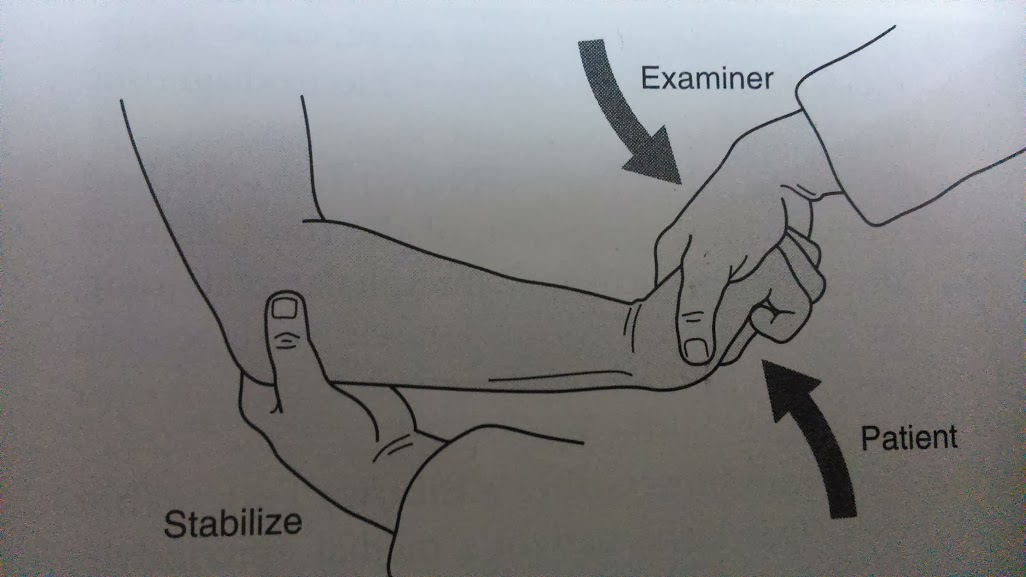Cozen’s Test: Difference between revisions
Evan Thomas (talk | contribs) No edit summary |
No edit summary |
||
| Line 18: | Line 18: | ||
To perform Cozen's test, the therapist stabilizes the patient's elbow in 90 degrees of flexion with one hand while palpating over the lateral epicondyle. The other hand positions the patient's hand into radial deviation and forearm pronation while the patient is asked to resisted wrist extension in this position against manual resistance of the therapist. The test is considered positive if it produces pain or reproduction of other symptoms in the area of the lateral epicondyle.<ref name="Valdes & LaStayo 2013">Valdes K, LaStayo P. The value of provocative tests for the wrist and elbow: a literature review. Journal of Hand Therapy, 2013; 26: 32-43.</ref> | To perform Cozen's test, the therapist stabilizes the patient's elbow in 90 degrees of flexion with one hand while palpating over the lateral epicondyle. The other hand positions the patient's hand into radial deviation and forearm pronation while the patient is asked to resisted wrist extension in this position against manual resistance of the therapist. The test is considered positive if it produces pain or reproduction of other symptoms in the area of the lateral epicondyle.<ref name="Valdes & LaStayo 2013">Valdes K, LaStayo P. The value of provocative tests for the wrist and elbow: a literature review. Journal of Hand Therapy, 2013; 26: 32-43.</ref> | ||
<br> | |||
[[Image:Cozen's test.jpg]] | |||
== Helpful Tips == | == Helpful Tips == | ||
Revision as of 19:36, 9 March 2014
Original Editor - Tyler Shultz
Top Contributors - Evan Thomas, Tony Lowe, Admin, Sheik Abdul Khadir, Rachael Lowe, Kim Jackson, Tyler Shultz, Ammar Suhail, Kai A. Sigel, WikiSysop, Oyemi Sillo, Wanda van Niekerk, Jennifer Chew and Laura Ritchie
Purpose
[edit | edit source]
| [1] |
The purpose of Cozen's test (also known as the "resisted wrist extension test" or "resistive tennis elbow test") is to check for lateral epicondylalgia or "tennis elbow".
Technique[edit | edit source]
To perform Cozen's test, the therapist stabilizes the patient's elbow in 90 degrees of flexion with one hand while palpating over the lateral epicondyle. The other hand positions the patient's hand into radial deviation and forearm pronation while the patient is asked to resisted wrist extension in this position against manual resistance of the therapist. The test is considered positive if it produces pain or reproduction of other symptoms in the area of the lateral epicondyle.[2]
Helpful Tips[edit | edit source]
To reduce the likelihood of finding pathology at the origin of extensor digitorum, keep the patient’s fingers flexed during resisted wrist extension. During isometric wrist extension, the counter-force should be applied on the dorsoradial aspect of the fist to reduce involving extensor carpi ulnaris and thus obtaining a false-positive finding if there is pathology within this muscle/tendon.[3]
Evidence[edit | edit source]
Sensitivity and specificity has not yet been determined.
Recent Related Research (from Pubmed)[edit | edit source]
Failed to load RSS feed from http://www.ncbi.nlm.nih.gov/entrez/eutils/erss.cgi?rss_guid=1RKSf0HH9l2y1BJYE1aDKC-fig7_va-wQrbK3TTqIwL1TpPoE-|charset=UTF-8|short|max=10: Error parsing XML for RSS
References
[edit | edit source]
- ↑ Tennis Elbow/Cozen's Test. Online video available from: https://www.youtube.com/watch?v=ehYTeDN4usc, last accessed 06/28/2013
- ↑ Valdes K, LaStayo P. The value of provocative tests for the wrist and elbow: a literature review. Journal of Hand Therapy, 2013; 26: 32-43.
- ↑ Kochar M, Dogra A. Effectiveness of a specific physiotherapy regimen on patients with tennis elbow: clinical study. Physiotherapy, 2002; 88: 333–341.







